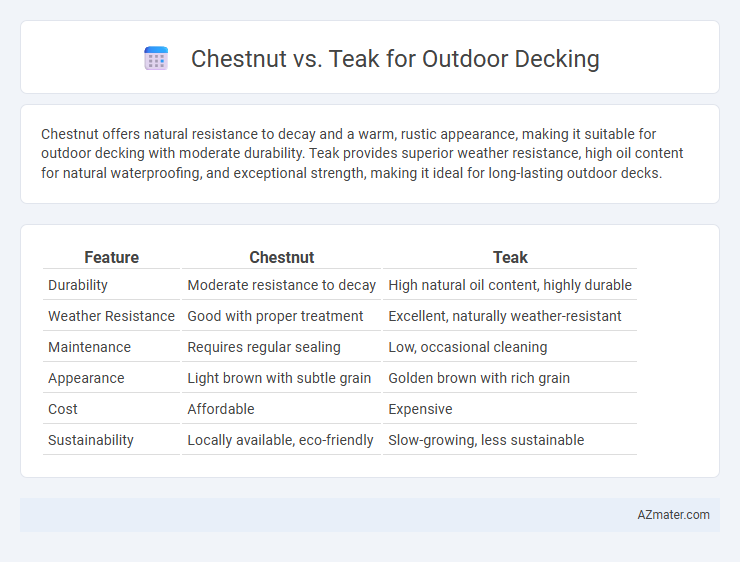Chestnut offers natural resistance to decay and a warm, rustic appearance, making it suitable for outdoor decking with moderate durability. Teak provides superior weather resistance, high oil content for natural waterproofing, and exceptional strength, making it ideal for long-lasting outdoor decks.
Table of Comparison
| Feature | Chestnut | Teak |
|---|---|---|
| Durability | Moderate resistance to decay | High natural oil content, highly durable |
| Weather Resistance | Good with proper treatment | Excellent, naturally weather-resistant |
| Maintenance | Requires regular sealing | Low, occasional cleaning |
| Appearance | Light brown with subtle grain | Golden brown with rich grain |
| Cost | Affordable | Expensive |
| Sustainability | Locally available, eco-friendly | Slow-growing, less sustainable |
Introduction to Chestnut and Teak for Outdoor Decking
Chestnut offers a durable and naturally rot-resistant option for outdoor decking, prized for its fine grain and warm, reddish-brown color that deepens over time. Teak is renowned for its exceptional weather resistance and high oil content, which protects the wood from water damage, insects, and decay, making it ideal for outdoor use in various climates. Both hardwoods provide long-lasting beauty and strength, with teak typically commanding a premium price due to its superior durability and natural oils.
Wood Characteristics: Chestnut vs. Teak
Chestnut features a light to medium brown hue with a coarse, straight grain and a moderate natural decay resistance, making it suitable for outdoor decking in mild climates. Teak offers a golden to medium brown color with tight, straight grain and exceptional natural oils that provide outstanding durability, water resistance, and insect resistance in harsh outdoor environments. The dense, oily composition of teak significantly reduces maintenance needs compared to chestnut, which requires regular sealing to enhance its lifespan.
Durability and Weather Resistance
Chestnut offers moderate durability with natural resistance to decay but requires regular maintenance to withstand harsh weather conditions, making it suitable for mild climates. Teak boasts exceptional durability and superior weather resistance due to its high oil content, which repels moisture, insects, and UV damage, ensuring longevity in diverse outdoor environments. For outdoor decking exposed to variable weather, teak remains the preferred choice for long-term performance and reduced upkeep.
Maintenance Requirements
Chestnut requires regular sealing and occasional sanding to maintain its resistance to moisture and prevent cracking, making maintenance moderately intensive. Teak naturally contains oils that provide excellent resistance to water, insects, and decay, significantly reducing the need for frequent sealing or treatment. Both woods benefit from periodic cleaning, but teak's durability results in lower overall maintenance demands for outdoor decking.
Visual Appeal and Color Choices
Chestnut outdoor decking showcases a warm, reddish-brown hue with rich, natural grain patterns that deepen with age, creating a timeless, rustic appearance. Teak offers a golden-brown color that weathers to a sophisticated silvery-gray patina, known for its smooth texture and consistent finish that complements modern and traditional designs alike. The choice between chestnut and teak depends on desired aesthetic longevity and color evolution, with chestnut providing a vibrant, evolving look and teak delivering a classic, refined ambiance.
Cost Comparison and Budget Considerations
Chestnut decking typically costs between $4 to $7 per square foot, making it more affordable than teak, which ranges from $8 to $15 per square foot due to its premium durability and rich appearance. Budget considerations should include long-term maintenance expenses, as chestnut may require more frequent sealing and treatment compared to teak's natural resistance to decay and insects. Choosing chestnut can result in lower initial installation costs, but teak offers enhanced longevity and reduced upkeep, influencing overall value over time.
Sustainability and Environmental Impact
Chestnut offers a sustainable choice for outdoor decking due to its fast growth rate and renewable sourcing, which reduces deforestation and carbon footprint. Teak, despite its durability and natural resistance to weather, often involves slower growth and higher environmental costs linked to illegal logging in some regions. Choosing chestnut supports eco-friendly forestry practices and lower environmental impact compared to traditional teak harvesting.
Slip Resistance and Safety Factors
Chestnut offers moderate slip resistance for outdoor decking, with its natural grain providing a textured surface that becomes safer when treated with non-slip coatings. Teak, renowned for its high natural oil content, provides excellent slip resistance even when wet, making it a preferred choice for poolside and marine environments. Safety factors favor teak due to its durability, resistance to weathering, and low tendency to warp or splinter, reducing potential hazards from uneven surfaces.
Installation and Workability
Chestnut offers excellent workability due to its medium density and uniform grain, making it easier to saw, plane, and nail during outdoor decking installation. Teak is denser and harder, requiring specialized tools for cutting and pre-drilling holes to avoid splitting, but its natural oils enhance durability and reduce maintenance. Both woods provide reliable structural stability, yet chestnut's ease of handling makes it preferable for DIY projects, while teak suits professional applications demanding long-term resilience.
Final Verdict: Choosing the Best Wood for Your Deck
Chestnut offers excellent durability and natural resistance to decay, making it a budget-friendly option for outdoor decking with a warm, reddish hue. Teak, renowned for its exceptional weather resistance, high oil content, and rich golden-brown color, provides a premium, long-lasting solution that requires less maintenance. For a cost-effective deck with good performance, chestnut is ideal, while teak suits those seeking unmatched durability and luxury aesthetics despite a higher price point.

Infographic: Chestnut vs Teak for Outdoor Decking
 azmater.com
azmater.com